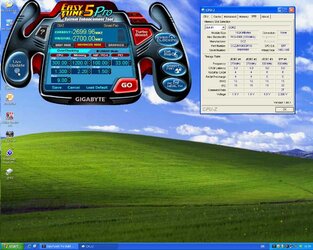- Joined
- Mar 11, 2008
Hi All,
I'm a bit of a Newbie to the overclocking scene and hoping that someone can help me.
I built my new unit over the weekend :-
Antec Nine Hundred Case
Corsair 620w Modular PSU
Gigabyte GA-X38-DS4
OCZ 2GB (2x1GB) PC2-8500C5 1066MHz SLI-Ready Dual Channel DDR2
Intel Core 2 Quad Q6600 Energy Efficient 95W edition CPU
Thermalright Ultra-120 Extreme Heatsink (SFLEX 1600rpm Fan)
8800GTS G92 512MB GDDR3 Dual DVI TV Out PCI-E Graphics Card
Samsung SpinPoint HD501LJ 500GB SATAII Hard Drive
Installed Windows XP Pro.
Updated the BIOS from version F1 to F2
Installed the Gigabyte monitoring software (Easy Tune 5)
The problem..... The system runs fine at stock with everything set to auto but when I attempt to up the FSB and restart, I can't get past post and the BIOS turns the FSB back to 266MHz.
I can use Easy Tune within Windows to overclock but cannot get it past 280MHz FSB. The PC will just stall. It's not a temperature problem as the chip was running at 27c stock and 33c fully loaded with Prime95.
I have tried playing with various setting (increasing the CPU voltage from 1.3 to 1.4) but it doesn't seem to make a difference. I did a lot of reading on forums before purchasing this board and many people have overclocked their 6600 over 3GHz with no problems.
Any suggestions would be greatfully appreciated.
Arthur
I'm a bit of a Newbie to the overclocking scene and hoping that someone can help me.
I built my new unit over the weekend :-
Antec Nine Hundred Case
Corsair 620w Modular PSU
Gigabyte GA-X38-DS4
OCZ 2GB (2x1GB) PC2-8500C5 1066MHz SLI-Ready Dual Channel DDR2
Intel Core 2 Quad Q6600 Energy Efficient 95W edition CPU
Thermalright Ultra-120 Extreme Heatsink (SFLEX 1600rpm Fan)
8800GTS G92 512MB GDDR3 Dual DVI TV Out PCI-E Graphics Card
Samsung SpinPoint HD501LJ 500GB SATAII Hard Drive
Installed Windows XP Pro.
Updated the BIOS from version F1 to F2
Installed the Gigabyte monitoring software (Easy Tune 5)
The problem..... The system runs fine at stock with everything set to auto but when I attempt to up the FSB and restart, I can't get past post and the BIOS turns the FSB back to 266MHz.
I can use Easy Tune within Windows to overclock but cannot get it past 280MHz FSB. The PC will just stall. It's not a temperature problem as the chip was running at 27c stock and 33c fully loaded with Prime95.
I have tried playing with various setting (increasing the CPU voltage from 1.3 to 1.4) but it doesn't seem to make a difference. I did a lot of reading on forums before purchasing this board and many people have overclocked their 6600 over 3GHz with no problems.
Any suggestions would be greatfully appreciated.
Arthur


